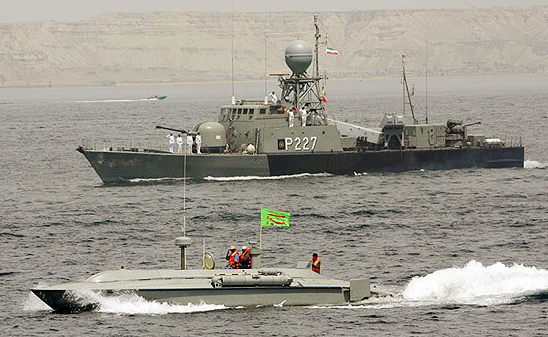|
|
|
An IRGC Navy fast attack speed boat (near boat). Image from Fars News. |
Thanksgiving weekend gave President Obama little to be thankful for in terms of the administration’s nuclear negotiations with Iran. Not only did Tehran turn down the offer of sending its nuclear material to Russia for enrichment, but the Iranians also declared a plan to construct 10 more nuclear enrichment facilities in future years. Despite the fact that mounting sanctions and technical hurdles make the construction of these new plants difficult, the recent rebuff by Ahmadinejad is disconcerting.
Even more troubling is news from the US Office of Naval Intelligence that Iran is in the process of restructuring its naval forces to give an arm of the Islamic Revolutionary Guard Corps full responsibility for strategic operations in the Persian Gulf. This transformation, which began in 2007, equips the IRGC with asymmetric assets like fast attack boats and cruise missiles. The goal of this restructuring is to craft a layered defense strategy aimed at protecting the Straight of Hormuz from foreign interference, especially from the US 5th Fleet, a central component of US military strategy in the Middle East. One IRGC Navy commander stated that if the 5th Fleet attempted to interfere in Iranian affairs, it would be turned into a “sea of fire” and “200,000 American soldiers will be seriously imperiled in the region.”
From the US Naval Intelligence report:
Additionally, Iran uses its naval forces for political ends such as naval diplomacy and strategic messaging. Most of all, Iranian naval forces are equipped to defend against perceived external threats. Public statements by Iranian leaders indicate that they would consider closing or controlling the Strait of Hormuz if provoked, thereby cutting off almost 30 percent of the world’s oil supply.
Both Ayatollah Khamenei and Ahmadinejad favor the Iranian Revolutionary Guard Corps Navy (IRGCN) over the Islamic Republic of Iran Navy (IRIN)-the conventional armed forces (called the Artesh) that existed prior to the 1979 Revolution. Many in the current regime view the IRIN as an imperial vestige left over from the days of the Shah. The report further explains that the IRGCN has been given “full responsibility for operations in the Persian Gulf” while the IRIN has been assigned to the Gulf of Oman and the Caspian Sea (less economically important waters).
The Guard Corps’ ideological disposition towards preserving the Khomeinist Revolution makes them strong political allies of the current regime, and this allegiance has not gone unnoticed. In the last decade, the Guard Corps’ navy has been given carte blanche for procuring new weapons systems. In addition to the over 2,000 mines already present in the Strait of Hormuz, the IRGCN is purchasing small attack boats that are less than 60 feet in length but are equipped with heavy firepower and can reach speeds of 60-70 knots. To pack an additional punch, Tehran has developed the Kowsar anti-ship cruise missile (a variant of the Chinese-made C-802) with an effective range that could inflict heavy damage in any ship in the strait. These naval assets are transforming the Strait of Hormuz into a shooting gallery for anyone attempting passage.
The Obama administration’s goal of deterring Iran via a strategy of collective security is challenged by the expansion of the Iranian navy. Discounting the US 5th Fleet (which is currently stretched while supporting the wars in Iraq and Afghanistan), there are no regional sea powers that could challenge Iranian hegemony. Are Western energy consumers comfortable with an Iranian stranglehold on one-third of the world’s oil supply? Time will only tell.
Are you a dedicated reader of FDD's Long War Journal? Has our research benefitted you or your team over the years? Support our independent reporting and analysis today by considering a one-time or monthly donation. Thanks for reading! You can make a tax-deductible donation here.









1 Comment
Actually this is the kind of move that the USA should welcome. A confrontation of fleets, an open move into direct military conflict of uniformed forces plays straight into the hands of the USA.